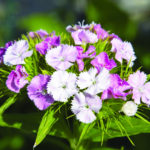Jane Austen’s writing is full of descriptions of flowers and their symbolism. This beautiful trio of flowers, also popular in Victorian gardens, are all mentioned in her letters.
Click here to view the full collection.
To grow your own Jane Austen Flower garden, start your Growbar between March and June.
Gently remove the plastic wrapping and place the Growbar with the protective paper facing upwards in a container which has plenty of space so it can expand; a takeaway food tray is ideal.
Pour half a litre of water into the tray and position the Growbar indoors on a warm, nright windowsill. The seeds will need to be a cosy 18-22’C to germinate.
When the Growbar is nearly dry, gently pour water into the base the tray, not directly onto the bar as it may crumble. You can be sure your Growbar is perfectly moist if it remains the colour of a rich dark ginger cake!
After a few weeks you should have a bar neatly dotted with little seedlings. These will be happy growing together in the bar for a further month in their sunny location.
When the seedlings have produced 4-8 leaves you can then gently separate them, being careful not to damage the delicate roots, and plant them in a sunny weed-free spot in the garden. Plants grown in the ground with plenty of space and sunlight will flower most impressively, but it is possible to grow the seedlings in large containers on the balcony or patio.
Start growing March - June
How to identify your seedlings:

Cornflower: with its electrical blue petals is an integral part of the British cottage garden. (Annual)
Seedlings have long, slightly silvery leaves. They like moist soil during spring and summer which helps prolong flowering. Dead flower heads can be removed to encourage flowering in autumn.

Sweet William: adds vibrant colour and graced the shrubbery border of the Austen garden at Chawton. (Biennial)
Seedlings have smooth, oval shaped leaves. They enjoy full sun to partial shade and are fully hardy.

Mignonette: bears small, sweet scented flowers; Austen wrote to sister Cassandra about its progress in their garden. (Annual Biennial)
Seedlings have pale green and long oval shaped leaves. The plants are happy in full sun and well-drained soil. Remove deadheads regularly to prolong flowering.
Growbar is 100% eco-friendly. The card packaging can be widely recycled, the film wrap is made from biodegradable sugar cane, and coir is a sustainable alternative to peat that’s made with coconut fibres.


